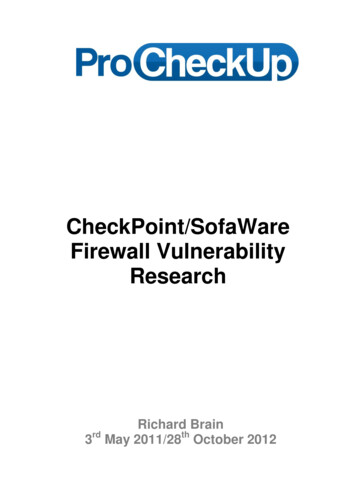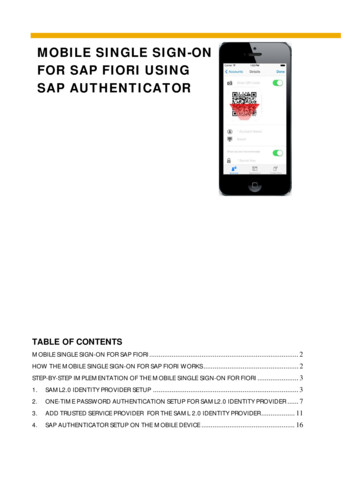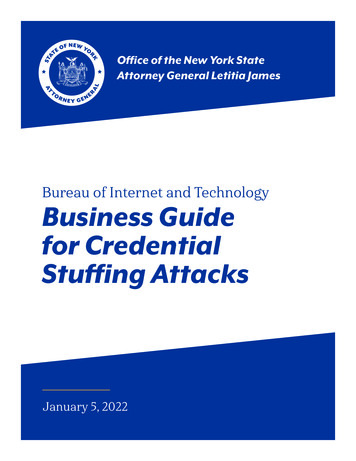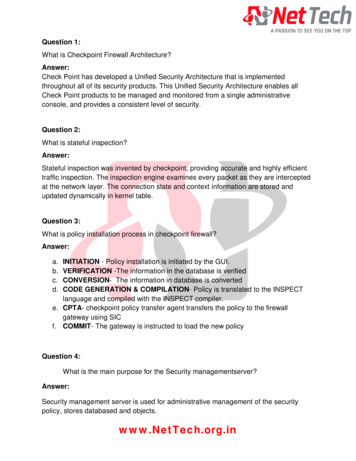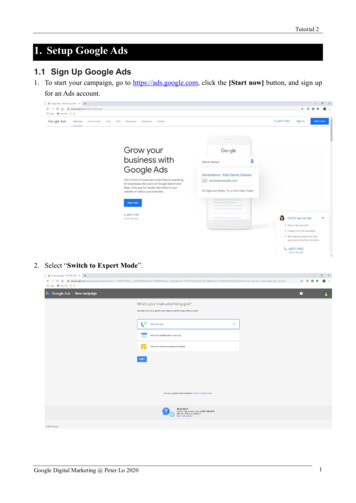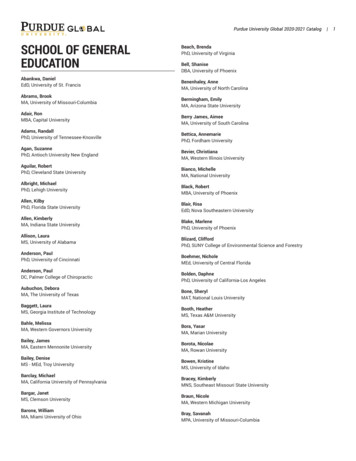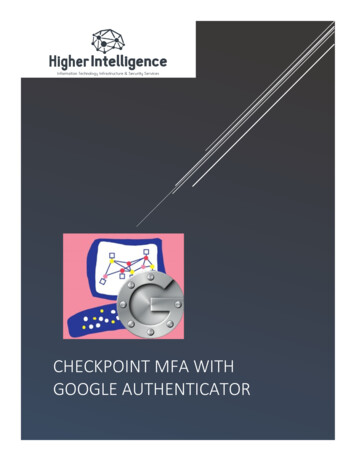
Transcription
CHECKPOINT MFA WITHGOOGLE AUTHENTICATOR
Vladimir Yakovlev101010@higherintelligence.comMost of us are familiar with Google Authenticator application and are already using it for a multitude of services. I wouldlike to describe the procedures that will make it possible to authenticate administrators and users to Check Point GaiaWeb UI and SSH as well as Smart Console applications and VPN using this application.This setup requires creation and maintenance of local accounts on RADIUS server. To simplify user onboarding, QRcodes will be generated for mobile Google Authenticator application registration.This guide is created with beginners in mind and does not require extensive Linux experience.NETWORK DIAGRAM, HOSTS AND IP ADDRESSES .2SETTING UP UBUNTU SERVER .4CONFIGURING NETWORK SETTINGS FOR UBUNTU SERVER .5CONFIGURING INITIAL FIREWALL SETTINGS.6CONFIGURING THE UBUNTU SERVER. 10INSTALLING FREERADIUS, QR GENERATOR AND SUPPLEMENTAL PACKAGES . 12INSTALLING GOOGLE AUTHENTICATOR . 12CONFIGURING FREERADIUS FOR MFA WITH GOOGLE AUTHENTICATOR . 12CONFIGURING CLIENTS ON FREERADIUS . 15CONFIGURING USERS ON FREERADIUS . 16SETTING UP LOCAL RADIUS USERS FOR ACCESS TO GAIA WEB UI AND CLISH . 20SETTING UP NON-LOCAL RADIUS USERS FOR WEB UI AND CLI . 25CONFIGURATION FOR ACCESS TO SMART CONSOLE APPLICATIONS . 26CONFIGURING RADIUS AUTHENTICATION FOR VPN USERS . 28LOGGING AUTHENTICATION EVENTS . 31REDIRECTING FREERADIUS LOGS TO CHECK POINT MANAGEMENT OR LOG SERVER . 32CONFIGURE CHECK POINT MANAGEMENT OR LOG SERVER TO ACCEPT SYSLOG MESSAGES . 35TESTING AND DEBUGGING . 39POSSIBLE FUTURE IMPROVEMENTS AND ACKNOWLEDGEMENTS . 411 Page
Vladimir Yakovlev101010@higherintelligence.comNetwork diagram, hosts and IP addressesIP addresses, host names and zone designations shown reflect those used in a lab environment for creation of thisdocument. Change those according to your requirements.Conventions:# Green on grey denotes existing text in files or prompts.Blue on grey indicates modified entries in files, commands and responses to theprompts made by you. Commands should be followed by pressing EEnterr# Code blocks are entities to be copied and pasted as directedHighlighted text signifies notes of importanceCCtrl xx ; CCtrl ww ; yyy ; nnn ; EEnterr , etc., represent key combinations, single key presses or sequences.2 Page
Vladimir Yakovlev101010@higherintelligence.comWhen making changes in configuration files, comment out the lines you are changing and create modified entries underthose. Create a commented-out delimiter above and below the changed entries to allow for easier searches later, i.e.:#---------------------- changed-by-admin1 -----------------------#original entry, commented-outModified entry#-------------------------- end-change --------------------------You can subsequently search configuration files for changes using “changed-by-admin1” pattern.3 Page
Vladimir Yakovlev101010@higherintelligence.comSetting up Ubuntu serverWe’ll be using the most widely deployed RADIUS server in the world, FreeRADIUS, running on Ubuntu distribution ofLinux.Install Ubuntu 16.04 LTS server with default settings on a platform of your choice. Do not encrypt user directories!!!You will need to provide the Ubuntu server with Internet access, at least during initial configuration. Once configurationis completed, you may restrict its access to the Internet completely if you have internal Time Server(s). If you are relyingon time-based tokens, your RADIUS server should retain capability to keep accurate time.Depending on installation method and target, you may be prompted with configuration options during setup. If so, enteryour hostname, user name, password and network settings as you go through the installation process. If some of theoptions shown in the table were not available during the installation, follow instructions below to make necessarychanges.Parameters (blue values used in the lab), note your own in the empty cellsHostname (fru16)User (fradmin)Password (FR@dmin)Time ZoneDNS-ResolversAmerica/New York8.8.8.8 single space 8.8.8.4If prompted with “Software Selection”options during installation, include“Standard System Utilities” and “OpenSSHServer” and skip the “Installing OpenSSH”section below.4 PageAddress (10.2.2.106)Netmask (255.255.255.0)Network (10.2.2.0)Broadcast (10.2.2.255)Gateway (10.2.2.1)Domain (-//-)DNS-Resolvers
Vladimir Yakovlev101010@higherintelligence.comIf you are proficient in Linux administration, install the following packages:ntp, build-essential, libpam0g-dev, freeradius, git, libqrencode3 and libpam-google-authenticator.Set the correct Time Zone, reboot the server and skip to page 6, Configuring Initial Firewall Settings. Use your ownchoice of editor; otherwise, follow the document.Logon using credentials defined during installation.Type:sudo suand press EEnterr . When prompted, use the password you have chosen during setup to elevate your privileges.Configuring Network Settings for Ubuntu ServerType (or copy and paste):nano /etc/network/interfacesInside the Nano editor, navigate to the iface line located under # The primary network interface,comment it out and paste “iface ens33 inet static” below, (your interface name may differ, but will be in identicallocation):# The primary network interfaceauto ens33#iface ens33 inet dhcpiface ens33 inet staticCopy and paste, if you can, or type these lines under the “iface ens33 inet static”, to configure IP address, gateway andDNS resolvers. Substitute values for address, mask, gateway and DNS servers with those pertinent to your network:address 10.2.2.106netmask 255.255.255.0network 10.2.2.0broadcast 10.2.2.255gateway 10.2.2.1# dns-* options are implemented by the resolvconf package, if installeddns-nameservers 8.8.8.8 8.8.4.4(Note the space between 8.8.8.8 and 8.8.4.4).Press CCtrl xx ; yyy and EEnterr to save changes and exit Nano.5 Page
Vladimir Yakovlev101010@higherintelligence.comType:sudo reboot nowto restart your Ubuntu server.We will continue configuration of the Ubuntu and FreeRADIUS once initial configuration of our firewall is completed.Configuring Initial Firewall SettingsAt this point in the process, we must configure the firewall to allow for the following actions:1.2.3.4.Access Ubuntu server from your management workstationAllow Ubuntu to resolve namesAllow Ubuntu to sync time with NTP servers or poolsPermit Internet access from Ubuntu for installation and updates of additional software packagesOur Check Point firewall topology, reflecting network diagram on Page 2, should look like this:Let’s create the host object representing our Ubuntu server and name it “fru16”, (abbreviated FreeRADIUS Ubuntu 16):6 Page
Vladimir Yakovlev101010@higherintelligence.comAnd its NAT properties set to “Add Automatic Address Translation rules” with Translation method set to “Hide”.Note, that in the future you mayhave to change the Translationmethod to “Static”, if you’lldecide to incorporate GoogleAuthentication for users definedin FreeRADIUS server forexternal services or devices.The object representing our Internal network and its NAT properties should be defined as well:7 Page
Vladimir Yakovlev101010@higherintelligence.comAs well as the object representing our management workstation, (do not set NAT properties):In SmartDashboard, “Firewall/NAT”, create the top two new rules shown here:8 Page
Vladimir Yakovlev101010@higherintelligence.comAnd in “Firewall/Policy”, re-create the rules shown below, defining new “Time” object to limit your FreeRADIUS server’sability to establish outbound connections to the Internet outside of its designated maintenance window:During the initial configuration, you may enable logging for the “dns” and “ntp” traffic to verify its functionality. Onceconfirmed, it makes sense to set “Track” values to “- None” to avoid excessive logging.The purpose of rule # 5 will become clear once we get to the “RADIUS Logging” section of this Guide.9 Page
Vladimir Yakovlev101010@higherintelligence.comConfiguring the Ubuntu ServerOnce the server is rebooted, do not logon locally. Instead, use the SSH client residing on your Windows management PC,(typically PuTTY), to establish a connection to your Ubuntu server. Adjust “Window” parameters as shown below if yourown are same as defaults. We will need the “Column” count exceeding default value to display uncorrupted QR codes;the Rows count is arbitrary, since we can adjust the height dynamically by resizing terminal window:Click “Yes” when prompted with “PuTTY Security Alert” and you should have established an SSH session.You can now perform remote administration as well as copy/paste operations.You must elevate your privileges to continue installation:fradmin@fru16: sudo su[sudo] password for fradmin: “Password assigned to fradmin”root@fru16:/home/fradmin#to get to the root of your directory (there is a space between cd and ):root@fru16:/home/fradmin# cd root@fru16: #10 P a g e
Vladimir Yakovlev101010@higherintelligence.comDownload the package lists from the repositories and update them to get information on the newest versions ofpackages and their dependencies:sudo apt-get updateInstall NTP modules, as we will rely on time-based tokens, (you may forego this step if, for example, you are runningUbuntu on a hypervisor and it is syncing time with the host):sudo apt-get install ntpWhen prompted:Do you want to continue? [Y/n], press y and EnterrCheck the default time zone and change it to the one you are in, (press Enter after each blue line):root@fru16:/home/fradmin# dateWed Nov 9 15:08:27 PST 2016root@fru16:/home/fradmin# cd root@fru16: # timedatectl set-timezone America/New Yorkroot@fru16: # timedatectlLocal time: Wed 2016-11-09 18:11:14 ESTUniversal time: Wed 2016-11-09 23:11:14 UTCRTC time: Wed 2016-11-09 23:11:16Time zone: America/New York (EST, -0500)Network time on: yesNTP synchronized: noRTC in local TZ: noroot@fru16: # service ntp restartroot@fru16: # dateWed Nov 9 18:11:30 EST 2016root@fru16: #rebootIf you do not know the correct definition of your Time Zone, perform search, (I am using Tahiti as example):fradmin@fru16: timedatectl list-timezones grep TahitiPacific/TahitiThen use the complete output of the search in your zone definition.Run the update again, to bring all the information about dependencies in line with freshly installed components.Execute:sudo apt-get update11 P a g e
Vladimir Yakovlev101010@higherintelligence.comInstalling FreeRADIUS, QR Generator and Supplemental PackagesNow install FreeRADIUS, a widely used open source RADIUS server:Execute:sudo apt-get install build-essential libpam0g-dev freeradius git libqrencode3When prompted:Do you want to continue? [Y/n]:press yyy and press EnterrAfter a few seconds, ( 30, depending on available bandwidth), FreeRADIUS is installed.Installing Google AuthenticatorPaste this line to the terminal and press Enter to install the Google Authenticator components:sudo apt-get install libpam-google-authenticatorConfiguring FreeRADIUS for MFA with Google AuthenticatorCreate a group for users whose access you may want to temporary disable in the future without deleting accounts:sudo addgroup radius-disabledEdit configuration files:sudo nano /etc/freeradius/radiusd.confFind lines:user freeradgroup freerad(Use Ctrl w to search in Nano)Comment both lines out, copy and paste these lines below:user rootgroup rootPress CCtrl xx ; yyy and EEnterr to save changes and exit Nano.12 P a g e
Vladimir Yakovlev101010@higherintelligence.comExecute:sudo nano /etc/freeradius/usersLook for this block of text:####Deny access for a group of users.Note that there is NO 'Fall-Through' attribute, so the user will notbe given any additional resources.And paste these three lines under it:DEFAULTDEFAULTGroup "radius-disabled", Auth-Type : RejectReply-Message "Your account has been disabled."Auth-Type : PAMPress CCtrl xx ; yyy and EEnterr to save changes and exit Nano.Execute:sudo nano /etc/freeradius/sites-enabled/defaultSearch for this block of text containing commented-out word “pam”. Insert uncommented line “pam” under it:##Pluggable Authentication Modules.pampamPress CCtrl xx ; yyy and EEnterr to save changes and exit Nano.Configure PAM to use a combination of the local user’s password and the PIN generated by Google Authenticator:Execute:sudo nano /etc/pam.d/radiusdFind and comment-out these four lines by prepending them with “#”:@include@include@include@include13 P a g ssion
Vladimir Yakovlev101010@higherintelligence.comPaste these two lines under the four lines commented out in the step above:auth requisite pam google authenticator.so forward passauth required pam unix.so use first passYour file should now look like this:# /etc/pam.d/radiusd - PAM configuration for FreeRADIUS## We fall back to the system default in /etc/pam.d/common-*##@include common-auth#@include common-account#@include common-password#@include common-sessionauth requisite pam google authenticator.so forward passauth required pam unix.so use first passPress CCtrl xx ; yyy and EEnterr to save changes and exit Nano.Execute:sudo nano /etc/freeradius/radiusd.confCtrl w ; find “auth”, comment it out and add line auth yes below:#auth noauth yes# Log passwords with the authentication requests.# auth badpass - logs password if it's rejected# auth goodpass - logs password if it's correct## allowed values: {no, yes}#auth badpass noauth goodpass noPress Ctrl x ; y and Enter to save changes and exit Nano.sudo rebootYou are now ready to set up clients and users, issue google-authenticator tokens and perform RADIUS authentication.14 P a g e
Vladimir Yakovlev101010@higherintelligence.comConfiguring Clients on FreeRADIUSClients are the hosts that authenticate Users against RADIUS.Example below shows how to configure two clients, one being our Check Point firewall’s DMZ IP address facing RADIUSserver, the other - our management workstation. Generally, the workstation would not be a client, but having it definedas such will allow us to conduct tests against RADIUS directly and to confirm its functionality in advance.Execute:sudo nano /etc/freeradius/clients.confScroll down with the arrow keys and append the file with section containing your Check Point management server, aswell as your management workstation. Replace IPs and “secret” with those pertinent to your environment. “Secret” isan authentication method that the Clients will be using when addressing RADIUS and corresponding entries will bedefined later in your firewall and your workstation. “Shortname” is simply a name under which RADIUS will be loggingyour Client’s activity.client 10.2.2.1 {secret SECRETshortname allinoneDMZ}#client 192.168.7.147 {secret SECRETshortname Precision}Press CCtrl xx ; yyy and EEnterr to save changes and exit Nano.15 P a g e
Vladimir Yakovlev101010@higherintelligence.comConfiguring Users on FreeRADIUSThe process of adding a user consists of the following steps:1.2.3.4.5.6.7.8.Add userNavigate to user’s home directoryChange the ownership of a login session to the one you have createdCreate google-authenticator tokenSet google-authenticator parametersRegister google-authenticator using QR or secret codeExit user’s sessionRestart FreeRADIUS processExecute commands depicted in blue below:root@fru16: # adduser cpmonitorAdding user cpmonitor' .Adding new group cpmonitor' (1004) .Adding new user cpmonitor' (1003) with group cpmonitor' .Creating home directory /home/cpmonitor' .Copying files from /etc/skel' .Enter new UNIX password: new user’s passwordRetype new UNIX password: new user’s passwordpasswd: password updated successfullyChanging the user information for cpmonitorEnter the new value, or press ENTER for the defaultFull Name []:CheckPoint MonitorRoom Number []: 123Work Phone []: 1-212-555-5555Home Phone []: 1-973-999-9999Other []: CheckPoint trainee accountIs the information correct? [Y/n] Yroot@fru16 # cd /home/cpmonitorroot@fru16/home/cpmonitor# su cpmonitorcpmonitor@fru16: google-authenticatorDo you want authentication tokens to be time-based (y/n) yhttps://www.google.com/chart?chs 200x200&chld M 0&cht qr&chl TCRP24LZGRL3WQOWRQ%26issuer%3Dubuntu16 P a g e
Vladimir Yakovlev101010@higherintelligence.comNote: Actual QR code will take up a squarelarger than 80 characters wide and long, soyou may have to resize the terminal windowto accommodate its size.If you are seeing a corrupt QR code, i.e. onecomprised of dashes, it is likely that youhave not defined terminal window width“100” on Page 10.If this is the case, simply press “n” to cancelthe operation, resize terminal window andrerun “google-authenticator” command.Your new secret key is: ZLVQMR7ZTCRP24LZGRL3WQOWRQYour verification code is 443998Your emergency scratch codes are:2929400971196238772060281671475477329657Do you want me to update your "/home/cpmonitor/.google authenticator" file (y/n)yDo you want to disallow multiple uses of the same authenticationtoken? This restricts you to one login about every 30s, but it increasesyour chances to notice or even prevent man-in-the-middle attacks (y/n) Do youwant to disallow multiple uses of the same authenticationtoken? This restricts you to one login about every 30s, but it increasesyour chances to notice or even prevent man-in-the-middle attacks (y/n) yBy default, tokens are good for 30 seconds. In order to compensate forpossible time-skew between the client and the server, we allow an extratoken before and after the current time. If you experience problems withpoor time synchronization, you can increase the window from its defaultsize of -1min (window size of 3) to about -4min (window size
Nov 09, 2016 · We will continue configuration of the Ubuntu and FreeRADIUS once initial configuration of our firewall is completed. Configuring Initial Firewall Settings At this point in the process, we must configure the firewall to allow for the following actions: 1. Access Ubuntu server from your management workstation 2. Allow Ubuntu to resolve names 3.

